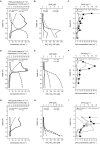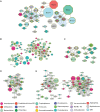Influence of Environmental Drivers and Potential Interactions on the Distribution of Microbial Communities From Three Permanently Stratified Antarctic Lakes
- PMID: 31156585
- PMCID: PMC6530420
- DOI: 10.3389/fmicb.2019.01067
Influence of Environmental Drivers and Potential Interactions on the Distribution of Microbial Communities From Three Permanently Stratified Antarctic Lakes
Abstract
The McMurdo Dry Valley (MDV) lakes represent unique habitats in the microbial world. Perennial ice covers protect liquid water columns from either significant allochthonous inputs or seasonal mixing, resulting in centuries of stable biogeochemistry. Extreme environmental conditions including low seasonal photosynthetically active radiation (PAR), near freezing temperatures, and oligotrophy have precluded higher trophic levels from the food webs. Despite these limitations, diverse microbial life flourishes in the stratified water columns, including Archaea, bacteria, fungi, protists, and viruses. While a few recent studies have applied next generation sequencing, a thorough understanding of the MDV lake microbial diversity and community structure is currently lacking. Here we used Illumina MiSeq sequencing of the 16S and 18S rRNA genes combined with a microscopic survey of key eukaryotes to compare the community structure and potential interactions among the bacterial and eukaryal communities within the water columns of Lakes Bonney (east and west lobes, ELB, and WLB, respectively) and Fryxell (FRX). Communities were distinct between the upper, oxic layers and the dark, anoxic waters, particularly among the bacterial communities residing in WLB and FRX. Both eukaryal and bacterial community structure was influenced by different biogeochemical parameters in the oxic and anoxic zones. Bacteria formed complex interaction networks which were lake-specific. Several eukaryotes exhibit potential interactions with bacteria in ELB and WLB, while interactions between these groups in the more productive FRX were relatively rare.
Keywords: McMurdo Dry Valley lakes; aquatic protists; environmental drivers; heterotrophic bacteria; interactions.
Figures






Similar articles
-
Establishment of microbial eukaryotic enrichment cultures from a chemically stratified antarctic lake and assessment of carbon fixation potential.J Vis Exp. 2012 Apr 20;(62):3992. doi: 10.3791/3992. J Vis Exp. 2012. PMID: 22546995 Free PMC article.
-
Protist diversity in a permanently ice-covered Antarctic lake during the polar night transition.ISME J. 2011 Sep;5(9):1559-64. doi: 10.1038/ismej.2011.23. Epub 2011 Mar 10. ISME J. 2011. PMID: 21390078 Free PMC article.
-
Microbial assemblages and associated biogeochemical processes in Lake Bonney, a permanently ice-covered lake in the McMurdo Dry Valleys, Antarctica.Environ Microbiome. 2024 Aug 20;19(1):60. doi: 10.1186/s40793-024-00605-1. Environ Microbiome. 2024. PMID: 39160591 Free PMC article.
-
Strong Seasonality in Arctic Estuarine Microbial Food Webs.Front Microbiol. 2019 Nov 29;10:2628. doi: 10.3389/fmicb.2019.02628. eCollection 2019. Front Microbiol. 2019. PMID: 31849850 Free PMC article. Review.
-
Subglacial Lake Whillans microbial biogeochemistry: a synthesis of current knowledge.Philos Trans A Math Phys Eng Sci. 2016 Jan 28;374(2059):20140290. doi: 10.1098/rsta.2014.0290. Philos Trans A Math Phys Eng Sci. 2016. PMID: 26667908 Review.
Cited by
-
Extreme Viral Partitioning in a Marine-Derived High Arctic Lake.mSphere. 2020 May 13;5(3):e00334-20. doi: 10.1128/mSphere.00334-20. mSphere. 2020. PMID: 32404515 Free PMC article.
-
Soil Geochemical Properties Influencing the Diversity of Bacteria and Archaea in Soils of the Kitezh Lake Area, Antarctica.Biology (Basel). 2022 Dec 19;11(12):1855. doi: 10.3390/biology11121855. Biology (Basel). 2022. PMID: 36552364 Free PMC article.
-
Trophic State Drives the Diversity of Protists in a Tropical River (New River, Belize).Microorganisms. 2022 Dec 7;10(12):2425. doi: 10.3390/microorganisms10122425. Microorganisms. 2022. PMID: 36557678 Free PMC article.
-
Freshwater phytoplankton diversity: models, drivers and implications for ecosystem properties.Hydrobiologia. 2021;848(1):53-75. doi: 10.1007/s10750-020-04332-9. Epub 2020 Jul 4. Hydrobiologia. 2021. PMID: 32836348 Free PMC article. Review.
-
Survival strategies of an anoxic microbial ecosystem in Lake Untersee, a potential analog for Enceladus.Sci Rep. 2022 May 5;12(1):7376. doi: 10.1038/s41598-022-10876-8. Sci Rep. 2022. PMID: 35513542 Free PMC article.
References
-
- Anderson M. J. (2001). A new method for non-parametric multivariate analysis of variance. Aust. Ecol. 26 32–46. 10.1111/j.1442-9993.2001.01070.pp.x - DOI
-
- Aronesty E. (2011). ea-utils: Command-line Tools for Processing Biological Sequencing Data. Durham, NC: Expression Analysis.
LinkOut - more resources
Full Text Sources

